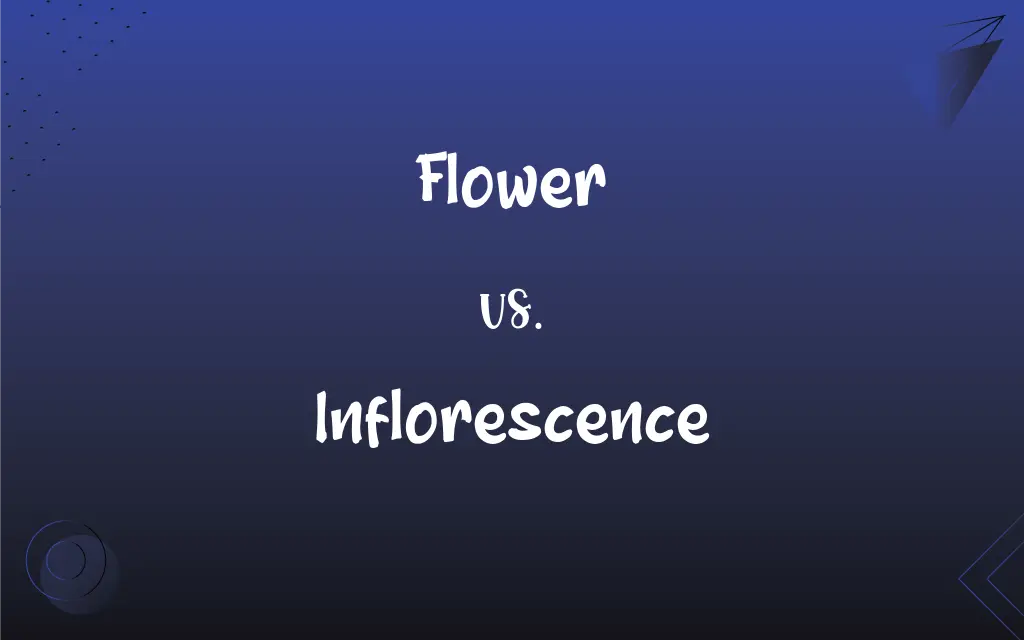Flower vs. Inflorescence: What's the Difference?
Edited by Aimie Carlson || By Harlon Moss || Updated on October 19, 2023
A flower is an individual reproductive unit of a plant; inflorescence is a group or cluster of flowers arranged on a stem.

Key Differences
A flower is essentially the reproductive structure of angiosperms (flowering plants). It contains the organs responsible for both the production and development of seeds. Flowers can be simple or complex, with a variety of colors, shapes, and sizes. On the contrary, inflorescence refers to the arrangement of multiple flowers on a stem, often in specific patterns and clusters.
While a single flower is equipped to facilitate the reproduction process with its petals, sepals, stamens, and carpels, inflorescence involves a more collective effort. The various flowers in an inflorescence might mature at different times, ensuring a longer duration of pollen availability or seed production. In this way, inflorescence can increase a plant's reproductive efficiency.
The beauty and diversity of flowers have not only made them subjects of admiration but also crucial for many ecosystems. They attract pollinators, ensuring the continuation of many plant species. Inflorescence, on the other hand, plays a strategic role in maximizing the chances of pollination. The collective presentation can attract more pollinators to the multiple flowers at once.
Understanding the difference between flower and inflorescence is crucial in botany and horticulture. While flowers are celebrated for their aesthetic and symbolic significance in various cultures, inflorescence provides valuable insights into the evolutionary strategies of plants. For instance, while a rose might be admired for its individual beauty as a flower, the arrangement of flowers in plants like lavender represents inflorescence.
Both flowers and inflorescence demonstrate the incredible diversity and complexity of plant life. Where flowers depict the intricate details of individual reproductive structures, inflorescence showcases the organized and collective arrangements plants have evolved to ensure successful reproduction.
ADVERTISEMENT
Comparison Chart
Definition
Reproductive unit of a plant.
Cluster of flowers on a stem.
Function
Facilitates plant reproduction.
Maximizes reproductive efficiency.
Complexity
Individual structure.
Collective arrangement of multiple flowers.
Examples
Rose, tulip, lily.
Lavender, dandelion head, sunflower head.
Significance in Botany
Studied for reproductive mechanisms.
Studied for evolutionary and strategic insights.
ADVERTISEMENT
Flower and Inflorescence Definitions
Flower
The reproductive structure in angiosperms.
The vibrant petals of the flower attracted many bees.
Inflorescence
A cluster of blooms on a single stalk.
The sunflower's inflorescence consists of many tiny flowers.
Flower
The seed-bearing part of a plant.
The flower turned into a fruit after pollination.
Inflorescence
The arrangement of flowers on a stem.
The inflorescence of the plant was a sight to behold.
Flower
A plant's organ containing its reproductive structures.
The flower's scent permeated the entire garden.
Inflorescence
A grouped assembly of individual floral units.
The inflorescence was still in the early stages of blooming.
Flower
An individual bloom on a plant.
Each flower on the bush added to its beauty.
Inflorescence
The flowering part of a plant excluding its individual blooms.
The tree's inflorescence was dense and widespread.
Flower
A blossom; the ornamental part of plants.
The child gave her mother a freshly plucked flower.
Inflorescence
A plant's strategy to present multiple flowers.
The inflorescence design ensures optimal pollination.
Flower
The reproductive structure of angiosperms, characteristically having either specialized male or female organs or both male and female organs, such as stamens and a pistil, enclosed in an outer envelope of petals and sepals.
Inflorescence
A cluster of flowers arranged in a characteristic way on a stem.
Flower
Such a structure having showy or colorful parts; a blossom.
Inflorescence
The process of flowering.
FAQs
Why do plants have inflorescences?
Inflorescences maximize a plant's reproductive efficiency by presenting multiple flowers collectively.
What is the primary function of a flower?
A flower's primary function is to facilitate plant reproduction.
Are all flowers colorful and fragrant?
No, while many flowers are colorful and fragrant, some are inconspicuous and lack any scent.
Are petals essential for reproduction?
While petals aid in attracting pollinators, they are not directly involved in the reproductive process.
Can a single stem with one flower be an inflorescence?
No, inflorescence refers to a grouping or arrangement of multiple flowers on a stem.
Is a sunflower head a single flower or an inflorescence?
A sunflower head is an inflorescence made up of many tiny flowers.
Why are flowers often colorful?
Flowers are often colorful to attract pollinators, aiding in their reproductive process.
Do all inflorescences produce seeds?
While inflorescences contain flowers that can produce seeds, not all flowers within an inflorescence might be successfully pollinated or produce seeds.
How does inflorescence differ from a bouquet?
Inflorescence is a natural arrangement of flowers on a plant, while a bouquet is a human-made assembly of cut flowers.
Is a rose an inflorescence?
No, a rose is an individual flower. However, a rose bush might have multiple flowers.
Can inflorescences have different shapes and patterns?
Yes, inflorescences can vary greatly in shape, size, and pattern based on the plant species.
How do flowers and inflorescences relate to fruits?
Flowers, after pollination and fertilization, can develop into fruits, while inflorescences are the arrangement of such flowers.
Do all plants produce flowers?
No, only angiosperms or flowering plants produce flowers. Gymnosperms, for example, produce cones.
Can an inflorescence contain flowers of different colors?
While uncommon, some plants can have inflorescences with flowers of varying colors.
What's the significance of flowers in human culture?
Flowers hold aesthetic, symbolic, and ceremonial value in many cultures, often representing love, beauty, and celebration.
What determines the arrangement of flowers in an inflorescence?
Genetic factors and evolutionary strategies determine the specific arrangement of flowers in an inflorescence.
How do flowers contribute to the ecosystem?
Flowers attract pollinators, leading to plant reproduction and ensuring biodiversity.
What's a common example of inflorescence in gardens?
Lavender, with its spike of multiple flowers, is a common inflorescence example.
Are inflorescences always upright?
No, inflorescences can be upright, drooping, or spread out, depending on the plant species.
Can flowers exist without being part of an inflorescence?
Yes, many plants have solitary flowers that aren't part of a larger inflorescence.
About Author
Written by
Harlon MossHarlon is a seasoned quality moderator and accomplished content writer for Difference Wiki. An alumnus of the prestigious University of California, he earned his degree in Computer Science. Leveraging his academic background, Harlon brings a meticulous and informed perspective to his work, ensuring content accuracy and excellence.
Edited by
Aimie CarlsonAimie Carlson, holding a master's degree in English literature, is a fervent English language enthusiast. She lends her writing talents to Difference Wiki, a prominent website that specializes in comparisons, offering readers insightful analyses that both captivate and inform.
































































